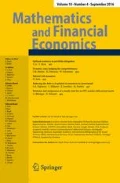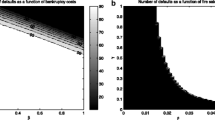Abstract
In this paper we study the implications of contingent payments on the clearing wealth in a network model of financial contagion. We consider an extension of the Eisenberg–Noe financial contagion model in which the nominal interbank obligations depend on the wealth of the firms in the network. We first consider the problem in a static framework and develop conditions for existence and uniqueness of solutions as long as no firm is speculating on the failure of other firms. In order to achieve existence and uniqueness under more general conditions, we introduce a dynamic framework. We demonstrate how this dynamic framework can be applied to problems that were ill-defined in the static framework.



Similar content being viewed by others
References
Acharya, V., Bisin, A.: Counterparty risk externality: centralized versus over-the-counter markets. J. Econ. Theory 149, 153–182 (2014)
Aliprantis, C.D., Border, Kim C.: Infinite Dimensional Analysis: A Hitchhiker’s Guide. Springer, New York (2007)
Amini, H., Filipović, D., Minca, A.: Systemic risk with central counterparty clearing. Swiss Finance Institute Research Paper No. 13-34, Swiss Finance Institute (2015)
Amini, H., Filipović, D., Minca, Andreea: Uniqueness of equilibrium in a payment system with liquidation costs. Oper. Res. Lett. 44(1), 1–5 (2016)
Awiszus, K., Weber, S.: The joint impact of bankruptcy costs, cross-holdings and fire sales on systemic risk in financial networks. Probab. Uncertain. Quant. Risk 2(9), 1–38 (2017)
Banerjee, T., Bernstein, A., Feinstein, Z.: Dynamic Clearing and Contagion in Financial Networks. In: Working paper (2018)
Barucca, P., Bardoscia, M., Caccioli, F., D’Errico, M., Visentin, G., Battiston, S., Caldarelli, G.: Network Valuation in Financial Systems. In: Working paper (2016)
Blanchet, J., Shi, Y.: Stochastic Risk Networks: Modeling, Analysis and Efficient Monte Carlo. Working paper (2012)
Capponi, A., Chen, P.-C.: Systemic risk mitigation in financial networks. J. Econ. Dyn. Control 58, 152–166 (2015)
Capponi, A., Chen, P.-C., Yao, D.D.: Liability concentration and systemic losses in financial networks. Oper. Res. 64(5), 1121–1134 (2016)
Chen, N., Liu, X., Yao, D.D.: An optimization view of financial systemic risk modeling: the network effect and the market liquidity effect. Oper. Res. 64(5), 1089–1108 (2016)
Cifuentes, R., Shin, H.S., Ferrucci, G.: Liquidity risk and contagion. J. Eur. Econ. Assoc. 3(2–3), 556–566 (2005)
Cont, R.: The end of the waterfall: default resources of central counterparties. J. Risk Manag. Financ. Inst. 8(4), 365–389 (2015)
Cont, R., Fournié, D.-A.: Functional Itô calculus and stochastic integral representation of martingales. Ann. Probab. 41(1), 109–133 (2013)
Cont, R., Minca, A.: Credit default swaps and systemic risk. Ann. Oper. Res. 247, 523–547 (2016)
Cont, R., Moussa, A., Santos, E.B.: Network structure and systemic risk in banking systems. In: Handbook on Systemic Risk, pp. 327–368. Cambridge University Press (2013)
Eisenberg, L., Noe, T.H.: Systemic risk in financial systems. Manag. Sci. 47(2), 236–249 (2001)
Elliott, M., Golub, B., Jackson, M.O.: Financial networks and contagion. Am. Econ. Rev. 104(10), 3115–3153 (2014)
Elsinger, H.: Financial Networks, Cross Holdings, and Limited Liability, vol. 156. Österreichische Nationalbank (Austrian Central Bank), Wien-Alsergrund (2009)
Elsinger, H., Lehar, A., Summer, M.: Risk assessment for banking systems. Manag. Sci. 52(9), 1301–1314 (2006)
Feinstein, Z.: Financial contagion and asset liquidation strategies. Oper. Res. Lett. 45(2), 109–114 (2017)
Feinstein, Z.: Obligations with physical delivery in a multi-layered financial network. In: Working Paper (2018)
Feinstein, Z., El-Masri, F.: The effects of leverage requirements and fire sales on financial contagion via asset liquidation strategies in financial networks. Stat. Risk Model 34(3–4), 113–139 (2017)
Feinstein, Z., Pang, W., Rudloff, B., Schaanning, E., Sturm, S., Wildman, M.: Sensitivity of the Eisenberg–Noe clearing vector to individual interbank liabilities. SIAM J. Financ. Math. 9(4), 1286–1325 (2018)
Feinstein, Z., Rudloff, B., Weber, S.: Measures of systemic risk. SIAM J. Financ. Math. 8(1), 672–708 (2017)
Gai, P., Kapadia, S.: Contagion in financial networks. In: Bank of England Working Papers 383. Bank of England (2010)
Glasserman, P., Young, H.P.: How likely is contagion in financial networks? J. Bank. Finance 50, 383–399 (2015)
Heise, S., Kühn, R.: Derivatives and credit contagion in interconnected networks. Eur. Phys. J. B 85(4), 115 (2012)
Klages-Mundt, A., Minca, A.: Cascading losses in reinsurance networks. In: Working Paper (2018)
Kusnetsov, M., Veraart, L.A.M.: Interbank clearing in financial networks with multiple maturities. In: Working Paper (2018)
Leduc, Matt, Poledna, S., Thurner, S.: Systemic risk management in financial networks with credit default swaps. J. Netw. Theory Finance 3(3), 19–39 (2017)
Liu, M., Staum, J.: Sensitivity analysis of the Eisenberg–Noe model of contagion. Oper. Res. Lett. 35(5), 489–491 (2010)
Markose, S.M., Giansante, S., Gatkowski, M., Shaghaghi, A.R.: Too interconnected to fail: Financial contagion and systemic risk in network model of CDS and other credit enhancement obligations of us banks. In: Technical Report DP 683, Economics Department, University of Essex (2010)
Milgrom, P., Roberts, J.: Comparing equilibria. Am. Econ. Rev. 84(3), 441–459 (1994)
Murphy, D.: The systemic risk of otc derivatives central clearing. J. Risk Manag. Financ. Inst. 5(3), 319–334 (2012)
Nier, E., Yang, J., Yorulmazer, T., Alentorn, A.: Network models and financial stability. J. Econ. Dyn. Control 31(6), 2033–2060 (2007)
Paddrik, M.E., Rajan, S., Young, P.: Contagion in the CDS market. In: OFR Working Paper 16-12, Office of Financial Research (2016)
Puliga, M., Caldarelli, G., Battiston, S.: Credit default swaps networks and systemic risk. Sci. Rep. 4, 6822 (2014)
Rogers, L.C.G., Veraart, L.A.M.: Failure and rescue in an interbank network. Manag. Sci. 59(4), 882–898 (2013)
Schuldenzucker, S., Seuken, S., Battiston, S.: Default ambiguity: credit default swaps create new systemic risks in financial networks. In: Working Paper (2017)
Schuldenzucker, S., Seuken, S., Battiston, S.: Finding clearing payments in financial networks with credit default swaps is PPAD-complete. In: Papadimitriou, C.H. (ed), 8th Innovations in Theoretical Computer Science Conference (ITCS 2017), volume 67 of Leibniz International Proceedings in Informatics (LIPIcs), pp. 32:1–32:20, Dagstuhl, Germany, (2017). Schloss Dagstuhl–Leibniz-Zentrum fuer Informatik
Upper, C.: Simulation methods to assess the danger of contagion in interbank markets. J. Financ. Stab. 7(3), 111–125 (2011)
Veraart, L.A.M.: Distress and default contagion in financial networks. In: Working paper (2018)
Author information
Authors and Affiliations
Corresponding author
Additional information
Publisher's Note
Springer Nature remains neutral with regard to jurisdictional claims in published maps and institutional affiliations.
A Proof of Proposition 3.17
A Proof of Proposition 3.17
Proof
Firstly, as in (6), the clearing wealths as a function of initial endowments are defined by
We will prove continuity by utilizing the closed graph theorem (see, e.g., [2, Theorem 2.58]) noting that Proposition 3.6 provides us with the condition that the clearing wealths map into a compact set. Theorem 4 of [34] immediately provides the monotonicity of the clearing wealths.
Fix \(x \in \mathbb {R}^{n+1}_+\) and let \(\mathcal {X}= x + [-1,1]^{n+1}\) be a closed compact neighborhood of x in the full Euclidean space \(\mathbb {R}^{n+1}\). Then we can define \(V^x: \mathcal {X}\rightarrow \mathbb {R}^{n+1}\) as the restriction (and possible expansion to negative terms) of the domain of V to \(\mathcal {X}\). The graph of \(V^x\) is given by:
To see that \({\text {graph}}V^x\) is closed let \((\hat{x}^k,\hat{V}^k)_{k \in \mathbb {N}} \subseteq {\text {graph}}V^x \rightarrow (\hat{x},\hat{V})\), then immediately
by continuity of the nominal liabilities matrix L. Therefore by the closed graph theorem we immediately recover that \(V^x\) is continuous for any \(x \in \mathbb {R}^{n+1}_+\), which implies that V is continuous at any x as well and thus \(V: \mathbb {R}^{n+1}_+ \rightarrow \mathbb {R}^{n+1}\) is a continuous mapping. \(\square \)
Rights and permissions
About this article
Cite this article
Banerjee, T., Feinstein, Z. Impact of contingent payments on systemic risk in financial networks. Math Finan Econ 13, 617–636 (2019). https://doi.org/10.1007/s11579-019-00239-9
Received:
Accepted:
Published:
Issue Date:
DOI: https://doi.org/10.1007/s11579-019-00239-9




